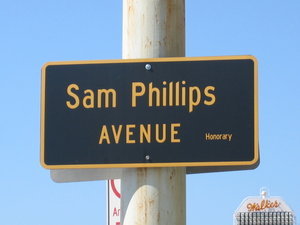Advertisement
Published: December 27th 2008
[youtube=nfeinqUm_sI][youtube=4Ou-6A3MKow][youtube=5XUAg1_A7IE]

 Sam Phillips Avenue
Sam Phillips Avenue
also known as Union Avenue, home of the Memphis Recording Service and Sun Records."Rocket 88" by Jackie Brenston and His Delta Cats", "Howlin' Wolf Boogie" and "Moanin' At Midnight" by Howlin' Wolf and "Bear Cat" by Rufus Thomas.
Suggested Food and Drink for this Entry: As Jackie Brenston sang in "Rocket 88", go around the corner and get a fifth, everbody in your car should take a little nip.
Ike Turner, B.B. King, Howlin’ Wolf, Rufus Thomas, Junior Parker, Little Milton, Elvis Presley, Carl Perkins, Johnny Cash, Jerry Lee Lewis, Roy Orbison. All American music legends who started their recording careers at a small recording studio located at 706 Union Avenue in Memphis owned by Sam Phillips. Although Ike Turner would go on to have success with his wife Tina well after the days he spent in the Union Avenue studio, his recording career started there and he never forgot those earliest days in the music business. A clip of Ike Turner's reunion with Sam Phillips at the Sun Studios from the movie
The Road to Memphis is included at the end of this entry.
My trip to Sun Studios was my last music related stop in Memphis. Maybe it should have been my first, considering the number of careers that started there. But somehow, working backwards to where it all began seemed fitting. The small studio was quite the contrast to the lavish excesses of Graceland, which I had just left.
The Sun Studio experience starts next door to the actual studio in a small soda fountain/gift shop/waiting room where you purchase your tickets for the guided tour. There is ample opportunity to buy CDs and about any piece of clothing or what-not bearing the Sun logo (with that said, somehow I did miss the lingerie section). Tours begin every half an hour so the shop gets a little crowded as the tour time approaches.
When the tour begins, you are taken to small museum over the soda fountain where your tour guide begins telling the “Sun Story” using the displays in the museum and snippets of songs recorded there at 706 Union Avenue. The tour guide (his name escapes me) on my tour used just the right combination of showmanship and old school-50’s DJ skills to keep tour very interesting to everyone in the group, which I would think could be challenge considering the range of knowledge of the Sun studios within the tour group. Our group consisted of folks ranging from pompadoured roots-rock weirdoes (as Robbie Fulks would call them) to older European couples who just looked on in amazement at times.
Sam Phillips opened the Memphis Recording Service at the Union Avenue Location in January 1950. Phillips goal at the time was to record musicians from the Memphis area who he felt were worthy being heard but who had no outlet for recording. During his first few years in the recording business, the recordings made at Phillips’ studio were leased to record companies in other parts of the country because Phillips had not yet founded Sun Records.
One of the first artists to come through the doors at 706 Union was a young DJ from radio station WDIA named Riley King. About this time, many of King’s fans had begun to refer to him as the “Singing Black Boy”. Of course, that name was shortened to B.B. and the King of the Blues has answered to the name since then. Over the span of the year and a half between January 1950 and the summer of 1951, King recorded five singles that were leased the Modern/RPM records located in Los Angeles. Although none of the releases were hits, King’s unique style was beginning to form and he cut his first hit, “3 O’clock Blues”, shortly thereafter in 1952.
Although B.B. King was the first “name” artist to record at Phillips’ Memphis Recording Service, an artist referred to Phillips by King recorded the first hit produced at the 706 Union Avenue studio. On March 5, 1951, a band led by Ike Turner entered the studio and recorded “Rocket 88”. Many music historians point to “Rocket 88” as the first rock and roll recording. That thinking over simplifies the history of rock much like the thinking Elvis Presley invented rock and roll. But, “Rocket 88” was one of the first songs to bring together many of elements of rock; distorted electric guitar, rolling piano, rollicking saxophone solos and lyrics about cars, women and booze, in one recording.
The vocal chores on “Rocket 88” were handled by Jackie Brenston, Ike Turner’s cousin who was a saxophone player in the band. So, when the record was released by Chess Records, it was credited to Jackie Brenston and his Delta Cats, not to Ike Turner. The song became a massive R&B hit, but left Turner bitter because he felt he wasn’t given his due credit. Turner later split with Brenston and became a talent scout for Modern/RPM Records before finding success in later years with his future wife, Tina.
In many interviews, Sam Phillips had been quoted as saying his greatest discovery during his time on Union Avenue was not Elvis Presley, but instead was Chester Burnett a performer better known as Howlin’Wolf. Phillips discovered Howlin’ Wolf via Wolf’s daily radio show on KWEM in West Memphis. At the time, the Wolf was already in his 40’s, having already been a farmer and a soldier before starting his music career. Phillips brought Howlin’ Wolf to the Union Ave. studio in the summer of 1951 when he recorded “How Many More Years” and Moanin’ At Midnight”, which would become Wolf’s first record on Chess Records. Over the next year, Howlin’ Wolf recorded several more songs for Sam Phillips before being lured to Chicago by Chess Records owner Leonard Chess. Years later when the Wolf was asked about his move from Memphis to Chicago, he was quoted as saying:
I had a four-thousand dollar car and $3,900 in my pocket. I’m the onliest one drove out of the South like a gentleman. This short blog entry about Howlin’ Wolf in no way does justice to the Wolf’s talent or his ferocious performing style. Phillips described Howlin’ Wolf’s studio performances with the following:
His eyes would light up, you’d see the veins on his neck and, buddy, there was nothing on his mind but that song. He sang with his damn soul. A clip of Howlin’ Wolf performing “How Many More Years” on a mid-1960’s TV appearance is included at the end of this entry. At least it gives a glimpse of the power Sam Phillips describes.
In early 1952, Sam Phillips decided to launch Sun Records. Disagreements with the Chess and RPM/Modern record companies over which artists’ recordings would go to each company helped drive Phillips to the decision to start his own label. Sun’s first hit came a year later in 1953 when Phillips decided to write an answer song to one of the biggest R&B hits of the day, Big Mama Thornton’s “Hound Dog”. The song was titled “Bear Cat” and Phillips called in WDIA disc jockey Rufus Thomas to record the song and immediately released it. The song followed “Hound Dog” up the charts and peaked at #3. But, what seemed to be Sun’s first big break was dampened by the fact the song was, musically, a carbon copy of “Hound Dog”. The head of Thornton’s record label and the holder of the publishing rights, Don Robey, quickly brought a copyright infringement suit against Phillips and Phillips was forced to turnover a portion of the writer’s royalty to Robey. It is somewhat ironic the first hit released on the Sun label was an answer song to what would later become one of Elvis’ biggest hits when he recorded it for RCA in 1956.
Throughout 1953 and 1954, Sam Phillips continued to record local blues and R&B acts for his fledgling Sun label. Among them were Junior Parker, whose song “Mystery Train” would gain more recognition after Elvis recorded it in 1955, Little Milton, Roscoe Gordon and the Prisonaires, a vocal group comprised of inmates from the Tennessee State Prison in Nashville. A tape of the Prisonaires had been given to Phillips in early 1953 and, although Phillips did not care for their smooth vocal sound, he set up a recording session for the group on June 1, 1953. The group was escorted to the Sun Studios by armed guards on that day when they recorded a song co-written by a member of the group, Johnny Bragg, titled “Just Walkin’ in the Rain”. The song became a moderate hit for the Prisonaires and Sun Records, but Johnny Ray’s 1956 cover of the song went to #2 on the pop charts.
About the time the Prisonaires were recording at Sun in 1953, a greasy haired white teenager from Memphis made his first appearance at Sun’s Union Avenue studio…….
Advertisement
Tot: 0.099s; Tpl: 0.011s; cc: 10; qc: 48; dbt: 0.0472s; 1; m:domysql w:travelblog (10.17.0.13); sld: 1;
; mem: 1.1mb









